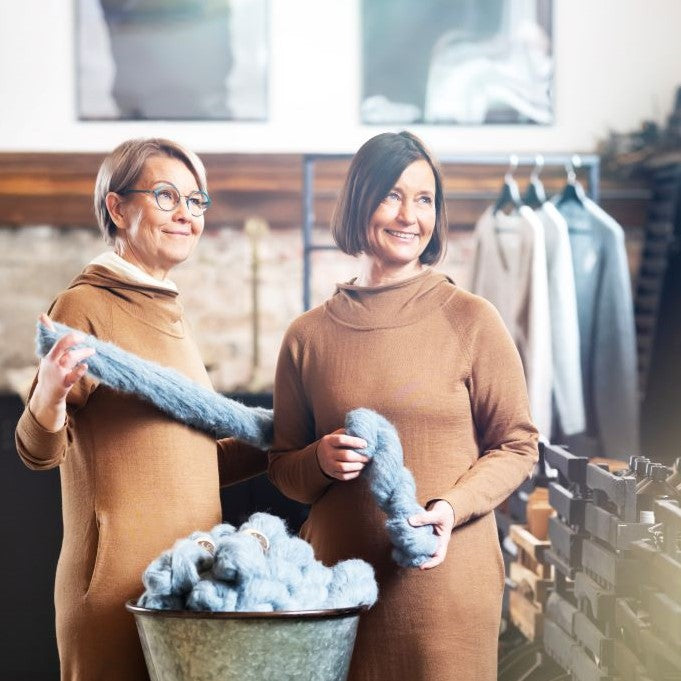
Angora rabbits - small wool producers
- The Angora rabbit is a long-haired form of rabbit that has been bred to produce a fine coat. The hair is collected and yarn is spun from it.
- Angora wool is valuable and therefore serious violations of animal rights have been observed in its production abroad.
- Ruukkin Kehräämö's partner is the domestic Viiliniity farm, where the activities are animal-friendly and ethical.
- When we talk about angora, we always mean the wool of the angora goat. Mohair is the official name for the wool of the Angora goat.
The noise of history
The origin of Angorakan is suspected to be in Turkey, where its name (Ankara) possibly comes from. The first written records of Angora rabbits have been made in 16th-century England. In the era of Henry VIII, the English Silk Hare was a highly valued material and was not allowed to be exported.
France has been the leading breeder of Angora rabbits until the 1960s. Other major producing countries are China, which has captured the market with its 90% share, as well as Japan, Korea, India, Germany, Chile, Argentina and Hungary. Angorakan wool production was at its peak in the 1990s. Wool production has leveled off in recent decades. In 2014, approximately 10,000 tons of angora rabbit wool were produced per year. It is the third most produced animal fiber in the world.
Different types of angora rabbits
Because angora goats started to be bred in different countries, several different subspecies of angora goat were born at the same time, whose wool is slightly different and suitable for different purposes.
- French Angora Rabbit: The French Angora has been developed since the 18th century. It is white in color and the wool has been developed into an easily processed fiber for industrial production.
- German Angora Rabbit: The German Angora was developed from the English Angora rabbit and its most important feature is the production of soft, dense and even hair. This species produces the most wool. The body is tubular, which makes winding easier.
- English Angora Rabbit: Descended from English Angora rabbits, but the current form was developed in the United States. This species has a particularly dense and soft coat and the animal is spherical. The coat sheds easily. The English is the smallest Angora breed.
- Satin Angora Rabbit: The Satin Angora descends from French-type Angoras and Satin Shorthairs. It was developed in the 1930s. The satin angora hair is very fine and refracts light beautifully, but it was found to be too weak to be machine spun.
- Nordic Angora Rabbit: Features of both English and French type Angora. Coat closer to the English Angora rabbit. There are several different colors of Nordic angora.
- Chinese Angora Rabbit: The Chinese Angora was developed from the German and French Angora and the New Zealand White Angora. Large producers of angora wool use angora crossbreeds with 70-90% German angora and 5-10% French angora.
- Giant Angora and other subtypes: The Giant Angora was developed from large German imports in the United States. The weight of the rabbit is at least 4.3 kg.
- In addition, there are e.g. jamora, dwarf angora and angora-furred luppies




Characteristics of angora wool
Angora fiber is dry and fat-free, just like alpaca fiber. Angora hair has air-filled cavities that give the hair its characteristic shine. Cavities also make the hair brittle and break easily, and therefore the hair itself cannot withstand heavy wear. 100% angora yarn is very warm, light and soft. However, it does not have the durability and elasticity characteristic of alpaca fiber. When combined with alpaca/wild silk fiber, angora yarn is more resistant to wear.
Like alpaca fiber, angora fiber also has a great ability to absorb moisture. It can absorb up to 60% of moisture (compared to its own weight) without still feeling damp. Angora fiber also has a high thermal insulation capacity, like alpaca fiber. The air cavities in the hair regulate the temperature and the heat produced by the body is slowly lost through the fine fiber knit. Angora is up to 10 times more heat-dissipative than sheep's wool. On the other hand, angora rabbit fiber is challenging to spin precisely because of its fine grain structure and inelasticity. Machine spinning requires great skill.
Angora chickens are shorn every 3-4 months, when the hair has grown to at least 6 cm in length. Because the fur is dense and fast-growing, you have to be careful of its felting and tangling. Not all hair is suitable for wool production. With good care and the right diet, one rabbit produces approx. 200 g of wool that can be spun. In trimming, the rabbit's characteristic features, ear tufts and cherry hairs are left. Four types of fiber can be distinguished from Angorakan wool:
- Cover hair
- Two types of intermediate wool
- Bottom wool
Angora rabbits have two different types of hair follicles, one of which grows all four fiber types, the other only the underwool and the underwool. In different types of angora, these fibers and hair follicles grow in different proportions, and there are also differences in the coarseness of the fibers. These are the criteria for evaluating the fineness of wool.
Angora wool has been considered a luxury product for centuries due to its properties and small production quantities. In recent years, videos of unethical behavior among Angora breeders have hit the headlines and become public. So please make sure that the wool you use is responsibly produced!
Collecting rabbits in Villiniitti is animal-friendly and is carried out on the rabbits' terms. At Ruukki's Kehräämö, yarn is spun from angora hemp wool. The mixing ratio we use is usually 90% angora and 10% alpaca or wild silk.
Sources:
Gamze Süpüren Mengüç, Nilgün Özdil and Gonca Özçelik Kayseri. (2014). Physical Properties of Angora Rabbit Fibers. American Journal of Materials Engineering and Technology, vol. 2, no. 2.
E. Dirgar and O. Oral. (2014). Yarn and Fabric Production from Angora Rabbit Fiber and Its End-Uses. American Journal of Materials Engineering and Technology, vol. 2, no. 2 (2014): 26-28.
Guzin Kanturk Yigit (2014). A young Rabbit Fiber Production in the World and Turkey . American Journal of Materials Engineering and Technology, vol. 2, no. 2
Levent Onal, Mahmut Korkmaz1 and Mustafa Tutak.(2007). Relations between the Characteristics of Angora Rabbit Fiber. Department of Textile Engineering, Erciyes University, Kayseri, Turkey. Kocasina Vocational School, Erciyes University, Kayseri, Turkey
Leena Boswell, PP presentation, Rabbit Breeders' Association
Maid Honka, Wild meadow farm
Pictures:
Leena Boswell and Piia Honka

































